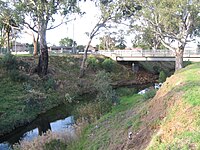
Werribee River

This article needs additional citations for verification. (January 2008) |

| Werribee | |
|---|---|
 Werribee River at Exford, downstream from Melton Reservoir | |
| Etymology | Aboriginal (Boonwurrung/Wathawurrung): wirribi meaning "backbone".[1][2] |
| Native name | Wirribi-yaluk (Wathawurrung)[1] |
| Location | |
| Country | Australia |
| State | Victoria |
| Region | Victorian Midlands (IBRA), Western District, Port Phillip |
| Local government areas | Moorabool, Melton, Wyndham |
| Cities | Ballan, Bacchus Marsh, Werribee |
| Physical characteristics | |
| Source | Great Dividing Range |
| • location | Wombat State Forest near Korweinguboora |
| • coordinates | 37°26′S 144°10′E / 37.433°S 144.167°E |
| • elevation | 501 m (1,644 ft) |
| Mouth | Port Phillip |
• location | near Werribee South |
• coordinates | 37°58′42″S 144°41′40″E / 37.97833°S 144.69444°E |
• elevation | 9 m (30 ft) |
| Length | 110 km (68 mi) |
| Basin features | |
| River system | Port Phillip catchment |
| Tributaries | |
| • left | Lerderderg River, Toolern Creek |
| National park | Werribee Gorge State Park |
| [3][4] | |
The Werribee River is a perennial river of the Port Phillip catchment that is located on the expansive lowland plain southwest of Melbourne, Victoria, Australia. The headwaters of a tributary, the Lerderderg River, are north of Ballan near Daylesford and it flows across the basalt plain, through the suburb of Werribee to enter Port Phillip. A linear park follows the Werribee River along much of its course. In total the Werribee River completes a journey of approximately 110 kilometres (68 mi).[5]

The river flows through the Werribee Gorge State Park before being utilised for irrigation of market gardens at Bacchus Marsh, then through Werribee where it is crossed by the Maltby By-pass. It then flows through the Werribee Open Range Zoo in Werribee Park, and finally the small coastal settlement of Werribee South before entering Port Phillip. The Western Treatment Plant, a sewage treatment site, is located near the mouth of the river, and supplies irrigation needs to the zoo.

The Werribee River Trail winds beside the Werribee River from Davis Creek in Tarneit to the Princes Highway in Werribee.

Etymology
The camped by the river on 15 December 1824 and named it the Arndell after Hovell's father-in-law. John Helder Wedge "re-discovered" the river in 1835 and initially called it the Peel, but then decided to call it the Ex or Exe. The name of the town of Exford, an early crossing place on the river, is derived from this name.[2] One of the local Wathaurong-speaking Kulin tribesman that accompanied Wedge said the name for the stream was 'Weariby Yallock' (yallock meaning 'stream'). The spelling changed to the present form of Werribee, the original Aboriginal root word meaning spine or backbone.[1]

History

Before the arrival of settlers, the Werribee River was the boundary of the Bunurong tribe whose six clans lived along the Victorian coast across the Mornington Peninsula, Western Port Bay to Wilsons Promontory.

In the late 1830s and 1840s, the Werribee River was the scene of conflict between the Wautharong people and the European colonisers. The squatter Charles Franks and a shepherd were speared to death near Mount Cottrell in July 1836. This resulted in the Mount Cottrell Massacre – a punitive party led by John Batman[clarification needed] which came upon a large party of Aboriginal people and indiscriminately shot and killed at least ten, There are accounts of arsenic-laced flour being given to them.

In 1851, a substantial timber bridge was built to cross the Werribee River to replace an earlier wooden bridge. In 1852, this bridge was washed away when the Werribee river flooded.[6]

In August 2004, the Victorian Government pledged A$300,000 (equivalent to A$472,648 in 2022) towards restoring the Werribee River, removing willows choking the river around the township and replacing them with native plants in a habitat restoration project.

Fishing
Werribee River holds fish all along its course, most of which are at the mouth of the river into Port Phillip Bay in the estuary. This area is best fished for southern black bream.

Features and highlights

Behind the Werribee golf course, the K-Road cliffs are perhaps the most unusual feature of the river, being sometimes described as looking like a river in Arnhem Land in the Northern Territory.[according to whom?]

The Werribee River is a regulated river system, with two dams on the river itself (Pykes Creek Reservoir and Melton Reservoir) and one on a tributary (Merrimu Reservoir on Pyrites Creek). These supply irrigation water to horticultural and vegetable farming users in Bacchus Marsh and Werribee South.

Gallery
-
Running through parkland in Ballan
-
Under the old Western Highway at Ballan
-
A ford across the river west of Bacchus Marsh
-
Marking the boundary between Bacchus Marsh and Maddingley
-
In flood over Cotrell Street in Werribee
See also
References
- ^ a b c Clark, Ian; Heydon, Toby (2011). "Historical Information: Werribee River". VICNAMES. Government of Victoria. Archived from the original on 7 April 2014. Retrieved 24 April 2018 – via Victorian Aboriginal Corporation for Languages.
- ^ a b Reed, A. W. (1973). Place names of Australia (1st ed.). Frenchs Forest: Reed Books. p. 224. ISBN 0-589-50128-3.
- ^ "Place Details: Werribee River". VICNAMES. Government of Victoria. Archived from the original on 7 April 2014. Retrieved 24 April 2018.
- ^ "Map of Werribee River, VIC". Bonzle Digital Atlas of Australia. Retrieved 7 April 2014.
- ^ "Werribee River". City of Wyndham.
- ^ "FLOODS". Geelong Advertiser and Intelligencer. Vol. XI, no. 1785. Victoria, Australia. 25 May 1852. p. 2 (DAILY and MORNING). Retrieved 29 June 2022 – via National Library of Australia.
External links
See what we do next...
OR
By submitting your email or phone number, you're giving mschf permission to send you email and/or recurring marketing texts. Data rates may apply. Text stop to cancel, help for help.
Success: You're subscribed now !






